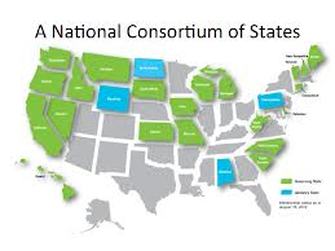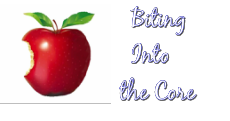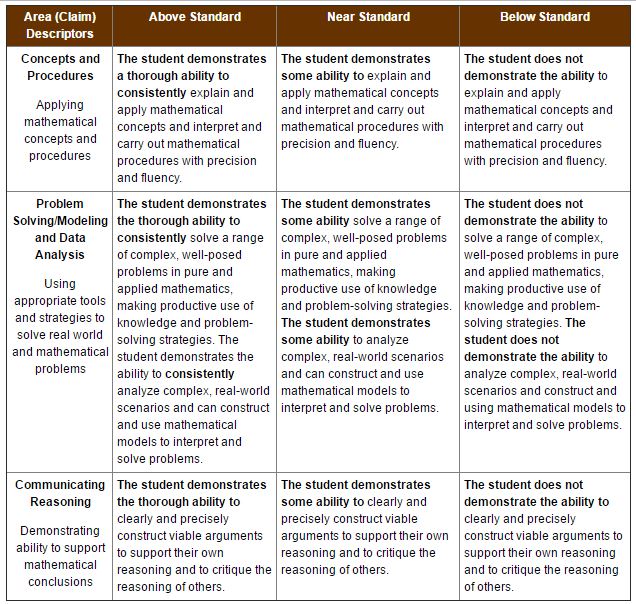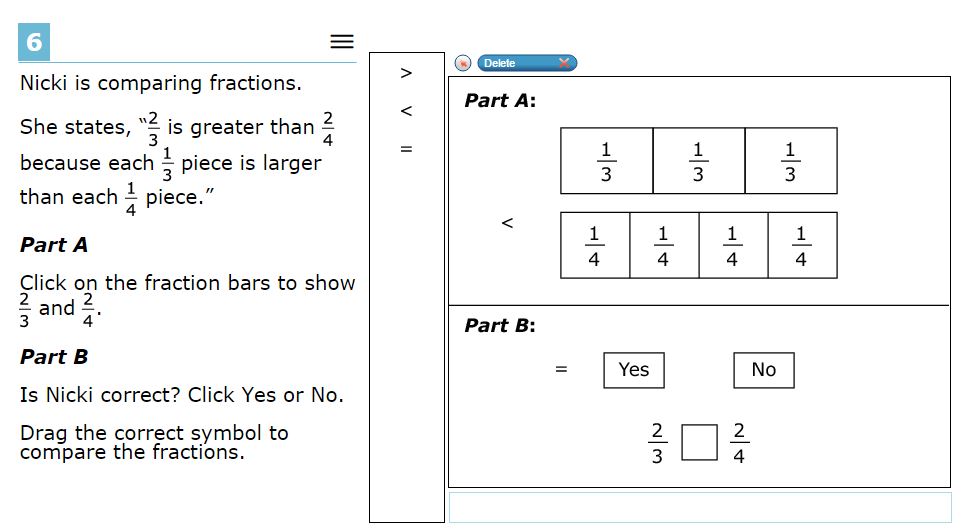Smarter Balanced Assessment

The Smarter Balanced Assessment Consortium is a state-led consortium working to develop assessments to accurately measure student progress toward college and career readiness. Here's a summary of the testing plan from the Smarter Balanced site:
The Smarter Balanced assessment system includes a variety of question types:
Based on student responses, the computer program adjusts the difficulty of questions throughout the assessment. For example, a student who answers a question correctly will receive a more challenging item, while an incorrect answer generates an easier question. By adapting to the student as the assessment is taking place, these assessments present an individually tailored set of questions to each student and can quickly identify which skills students have mastered. This approach represents a significant improvement over traditional paper-and-pencil assessments used in many states today.
What about performance tasks? Smarter Balanced describes performance tasks this way:
Performance tasks are extended activities that measure a student’s ability to integrate knowledge and skills across multiple standards—a key component of college and career readiness. Performance tasks will be used to better measure capacities such as depth of understanding, research skills, and complex analysis, which cannot be adequately assessed with selected-or short constructed-response items. Some performance tasks can be scored automatically; many will be hand-scored by professionally trained readers.
The video below details the task development process:
The Smarter Balanced assessment system includes a variety of question types:
- Selected-response items prompt students to select one or more responses for a set of options.
- Non-traditional response questions take advantage of computer-based administration to assess a deeper understanding of content and skills than would otherwise be possible with traditional item types. These kinds of questions might include drag-and-drop, editing text, or drawing an object.
- Constructed-response questions prompt students to produce a text or numerical response in order to collect evidence about their knowledge or understanding of a given assessment target.
- Performance tasks measure a student’s ability to demonstrate critical-thinking and problem-solving skills. Performance tasks challenge students to apply their knowledge and skills to respond to complex real-world problems. They can be best described as collections of questions and activities that are coherently connected to a single theme or scenario. These activities are meant to measure capacities such as depth of understanding, writing and research skills, and complex analysis, which cannot be adequately assessed with traditional assessment questions. The performance tasks are taken on a computer (but are not computer adaptive) and will take one to two class periods to complete.
Based on student responses, the computer program adjusts the difficulty of questions throughout the assessment. For example, a student who answers a question correctly will receive a more challenging item, while an incorrect answer generates an easier question. By adapting to the student as the assessment is taking place, these assessments present an individually tailored set of questions to each student and can quickly identify which skills students have mastered. This approach represents a significant improvement over traditional paper-and-pencil assessments used in many states today.
What about performance tasks? Smarter Balanced describes performance tasks this way:
Performance tasks are extended activities that measure a student’s ability to integrate knowledge and skills across multiple standards—a key component of college and career readiness. Performance tasks will be used to better measure capacities such as depth of understanding, research skills, and complex analysis, which cannot be adequately assessed with selected-or short constructed-response items. Some performance tasks can be scored automatically; many will be hand-scored by professionally trained readers.
The video below details the task development process:
Student scores are reported on their performance on 4 claims:
California has also provided sample CAASPP reports in English and in Spanish. Student results are described as above standard, at/near standard, or below standard for each of the Claims (Claims 2 and 4 are combined for reporting purposes.)
- Claim #1 - Concepts and Procedures (data comes from the Computer Adaptive Test)
- Claim #2 - Problem Solving (data comes from the Computer Adaptive Test and the Performance Task)
- Claim #3 - Communicating Reasoning (data comes from the Computer Adaptive Test and the Performance Task)
- Claim #4 - Modeling and Data Analysis (data comes from the Computer Adaptive Test and the Performance Task)
- Scale scores are the student's overall numerical score. Scale scores can be used to look at student's currently level of achievement and growth over time.
- Achievement Levels - Based on their scale scores, students fall into one of four categories of performance called achievement levels.
California has also provided sample CAASPP reports in English and in Spanish. Student results are described as above standard, at/near standard, or below standard for each of the Claims (Claims 2 and 4 are combined for reporting purposes.)
You can check out sample assessment problems like the one below at Smarter Balanced. You can log in as guest with a password "guest" and then select a grade level to explore. You will have a choice of practice tests (which practice grade level content) or training tests (which you can use to explore the technology features of the test). There are also sample performance tasks.



